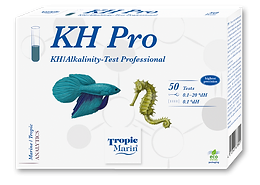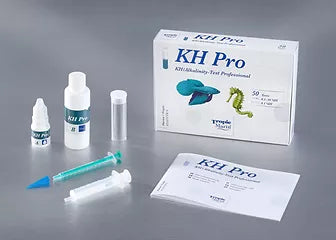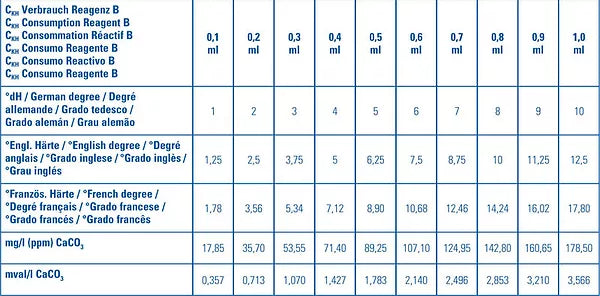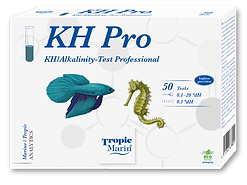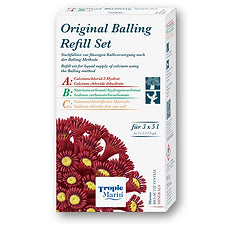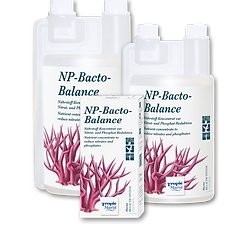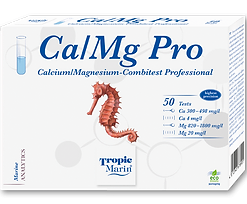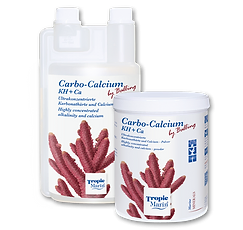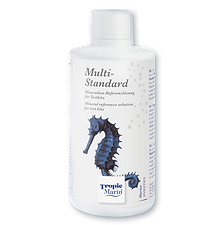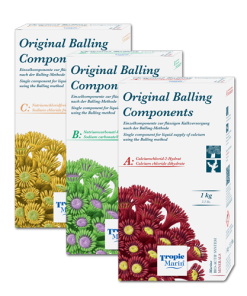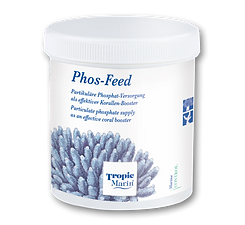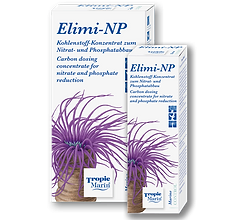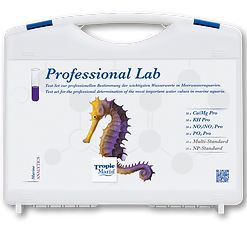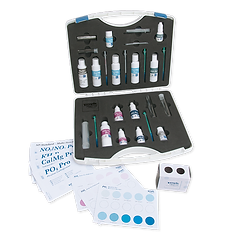KH Pro Test
Carbonate hardness / alkalinity test professional for fresh and saltwater aquariums
Measuring range & accuracy
Measurement range: 0.1 – 20 °dH
Accuracy: 0.1 °dH
About alkalinity
The carbonate hardness (KH) or alkalinity* of a water sample characterises the buffering capacity, i.e. the ability to maintain the pH value of the water. It is primarily defined by the proportion of hydrogen carbonate ions in the water. As the pH value increases, other basic ions such as the hydroxide ions also contribute to the alkalinity.
The alkalinity should be tested in all aquariums regularly. If the alkalinity in the aquarium is too low, the pH value can sink (sudden drop in acidity) to a level which is life-threatening for many fish and invertebrates. In reef aquariums, an adequate alkalinity is essential for strong coral growth. On the other hand, an overly high alkalinity in saltwater tanks can lead to lime precipitates and also have a negative impact on coral growth.
*There are many terms in water chemistry to describe the buffering capacity with varying definitions. The term “carbonate hardness” is customary in reef- and fishkeeping; however, it is the alkalinity which is measured. In this test, both terms are used synonymously.
The reading for alkalinity is usually given in degrees of German hardness (°dH). You can find a table for converting this unit into other common units (such as the equivalence unit millival per litre (mval/l) or the volume of substance in mmol/l) on the unfolded cover page.
Natural seawater has an alkalinity of 6.5 °dH. The alkalinity in saltwater aquariums should range from 6 to 9 °dH. The alkalinity in freshwater aquariums should not fall below 3 °dH. The optimum alkalinity level in freshwater aquariums depends on the species of fish and plants being kept. Ask your specialist retailer for the correct alkalinity for your tank.
Package contents
-
10 ml / 0.34 fl.oz. of reagent A
-
50 ml / 1.69 fl.oz. of reagent B
-
1 glass cuvette 10 ml
-
1 dosing syringe 5 ml
-
1 dosing syringe 1 ml with dropper tip
-
1 instruction for use
Professional packing and fast shipping
We offer a broad range of shipping options due to our long-standing partnerships with UPS, FedEx and DHL. Our warehouse staff are expertly trained and will wrap your items according to our precise and precise specifications. Your goods will go through a thorough inspection and be securely secured prior to being delivered. Everyday we deliver thousands of packages to customers from all over the world. Our dedication to becoming the largest online retailer worldwide is demonstrated by this. The distribution centers and warehouses distribution are situated in Europe, as well as the USA.
Please note that orders with more than one item are subject to a processing period that is based to the item.
Prior to shipping We will inspect thoroughly the items you've purchased. The majority of orders will be shipped within 48 hours. Delivery is expected to take between 3 and seven days.
Returns
Stock is dynamic. It is not managed entirely by us since we are involved with multiple parties such as the factory and our storage. The actual levels of stock can change at any time. Be aware that your order may be out of stock once the order is placed.
Our policy runs for 30 days. If it's been more 30 days since the date you purchased your item, we unfortunately can't give you a complete exchange or refund.
Your item should be in the original packaging and be unused. It must also be in the original packaging.
Related products
Water Chemistry
Water Chemistry
Water Chemistry
Water Chemistry
Water Chemistry
Fish food
Water Chemistry
Coral Food
Water Chemistry
Water Chemistry
Water Chemistry
Test Tubes
Water Chemistry
Water Chemistry
Water Chemistry
Water Chemistry
Water Chemistry
Fish food
Water Chemistry
Water Chemistry
Water Chemistry
Fish food
Water Chemistry
